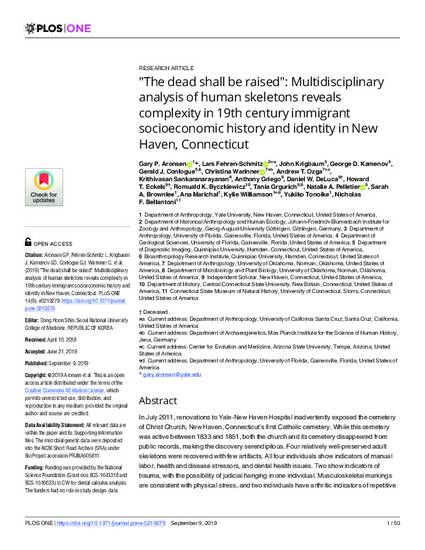
- Teeth,
- Osteology,
- Europe,
- Catholicism,
- Calculus,
- Strontium,
- Infectious disease,
- Polymerase Chain Reaction
In July 2011, renovations to Yale-New Haven Hospital inadvertently exposed the cemetery of Christ Church, New Haven, Connecticut’s first Catholic cemetery. While this cemetery was active between 1833 and 1851, both the church and its cemetery disappeared from public records, making the discovery serendipitous. Four relatively well-preserved adult skeletons were recovered with few artifacts. All four individuals show indicators of manual labor, health and disease stressors, and dental health issues. Two show indicators of trauma, with the possibility of judicial hanging in one individual. Musculoskeletal markings are consistent with physical stress, and two individuals have arthritic indicators of repetitive movement/specialized activities. Radiographic analyses show osteopenia, healed trauma, and other pathologies in several individuals. Dental calculus analysis did not identify any tuberculosis indicators, despite osteological markers. Isotopic analyses of teeth indicate that all four were likely recent immigrants to the Northeastern United States. Nuclear and mitochondrial DNA were recovered from three individuals, and these analyses identified ancestry, hair/eye color, and relatedness. Genetic and isotopic results upended our initial ancestry assessment based on burial context alone. These individuals provide biocultural evidence of New Haven’s Industrial Revolution and the plasticity of ethnic and religious identity in the immigrant experience. Their recovery and the multifaceted analyses described here illuminate a previously undescribed part of the city’s rich history. The collective expertise of biological, geochemical, archaeological, and historical researchers interprets socioeconomic and cultural identity better than any one could alone. Our combined efforts changed our initial assumptions of a poor urban Catholic cemetery’s membership, and provide a template for future discoveries and analyses.
Available at: http://works.bepress.com/andrew-ozga/31/

© 2019 Aronsen et al. This is an open access article distributed under the terms of the Creative Commons Attribution License, which permits unrestricted use, distribution, and reproduction in any medium, provided the original author and source are credited.